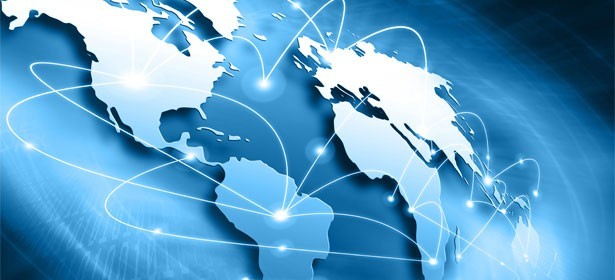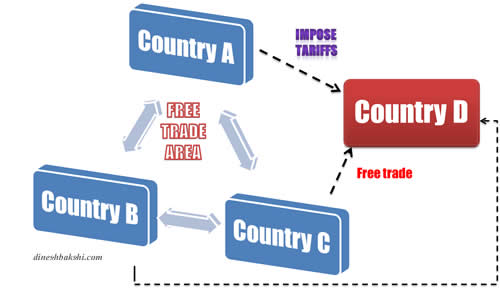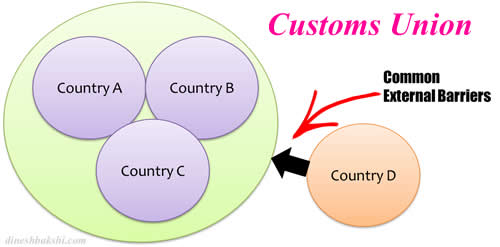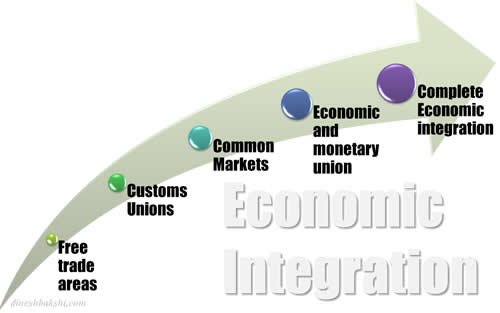Importance of International Trade
Exports & Imports
Exports are the movement of goods or commodities out of the country.
Imports are the movement of goods or commodities into the country.
Visible Trade
Visible trade involves trading of goods which can be touched and weighed. Examples include trade in goods such as Oil, machinery, food, clothes etc.
Visible Trade consists of
- Visible exports: Selling of tangible goods which can be touched and weighed to other countries.
- Visible imports: Buying of tangible goods which can be touched and weighed from other countries.
Balance of trade
It is the difference between the value of visible exports and value of visible imports of a country.
If the value of visible exports is more than visible imports the country will have a Surplus balance of trade.
If the value of visible imports is more than visible exports the country will have an Unfavourable balance of trade.
Invisible trade
Invisible trade involves the import and export of services rather than goods. Example include services such as insurance, banking, tourism, education.
If a UK student comes to Singapore to study, it would be invisible export for Singapore as it is earning foreign exchange by providing educational services.
If a Singapore citizen travels to UK for a holiday. It will be invisible import for Singapore and invisible export for UK.
Balance of invisible trade
It is the difference between the value of invisible exports and value of invisible imports of a country.
What is Free Trade?
Free trade is a system of trade policy that allows traders to trade across national boundaries without interference from the respective governments.
Reasons for Free Trade
Domestic Non-availability: A nation trades because it lacks the raw materials, climate, specialist labour, capital or technology needed to manufacture a particular good. Trade allows a greater variety of goods and services.
Cost effectiveness: It is cheaper to buy from other countries rather than producing themselves.
Benefits of Trade
Lower prices for consumers: When there is free trade, consumers can free to buy goods from the producer who is willing to sell at the lowest prices. Hence consumers gain from lower prices.
Greater choice for consumers: With free trade, consumers have access to variety of goods and services from different producers across the globe. This means more choice.
Ability of producers to benefit from economies of scale: Producers have access to a larger market thus they can produce more at lower cost and benefit from economies of scale.
Ability to acquire needed resources: Through free trade producers can not only sell in a large market but also gain from purchasing from suppliers across the world.
More efficient allocation of resources: When there is free trade, the most efficient producers get the opportunity to produce due to their cost efficiency. This leads to productive efficiency.
Increased competition: In free trade producers from different regions can compete with each other in terms of price, quality and variety. Increased competition leads to efficient allocation of resources.
Source of foreign exchange: Free trade involves the transaction of goods and services between nations. In order to purchase goods from abroad (imports), we need foreign currency. This is possible through exporting of goods to other countries.
Arguments in favour of protectionism
Infant industry argument: It is argued that government should go in for protectionist measure to protect infant industries, or else they will not get an opportunity to survive due to international trade.
Efforts of a developing country to diversify: Developing countries need to protect industries in which they want to diversify.
Protection of employment: Protecting domestic industries also means protecting domestic employment.
Source of government revenue: Tariffs form a good source of revenue for governments.
Strategic arguments: it means use of a tariff to protect military capability. The idea is, to consume the goods of our country to promote the national industry and so, in the case of war we don't have to buy the products in a foreign country and our industries have the capacity to produce all the goods that our country need. We want tariffs to reduce the “dependence” on international resources.
Means to overcome a balance of payments disequilibrium: High imports as compared to exports might lead to severe balance of payments issues. Government might resort to protectionist measures such as tariffs and quotas to restrict import and thereby control the balance of payment disequilibrium.
Anti-dumping: Dumping is when manufacturers export a product to another country at a price either below the price charged in its home market. This harms the domestic industry and employment. The importing country might resort to protectionist measures such as tariffs to control dumping of these goods.
Arguments against Protectionism
misallocation of resources: It leads to global misallocation of resources, as it supports inefficient producers and in certain cases (tariffs and quotas) consumer surplus is scarified.
the danger of retaliation and “trade wars”: Continuous protectionist measures by a country might lead to retaliation of other countries and they might also put protectionist measures on the imports.
the potential for corruption: Putting administrative controls might also lead to corruption.
increased costs of production due to lack of competition: Constant protection to the domestic producers and lack of competition propagates inefficiency and lack of initiative to control cost.
higher prices for domestic consumers: As we can see due to tariffs and quotas domestic consumers end up paying more.
Increased costs of imported factors of production: Imported goods become expensive which might also lead to imported inflation.
reduced export competitiveness: Continuous protection to domestic industries (such as subsidies) might make them inefficient in terms of cost and technology. In the long run they might become uncompetitive in the exports market.
What is economic integration?
Economic integration refers to trade unification between different states by the partial or full abolishing of customs tariffs on trade taking place within the borders of each state.
This is meant in turn to lead to lower prices for distributors and consumers (as no customs duties are paid within the integrated area) and the goal is to increase trade.
.png)

What is a trade agreement?
A trade agreement is a contract/agreement/pact between two or more nations that outlines how they will work together to ensure mutual benefit in the field of trade and investment.
Trade agreements are often regional, involving only a relatively small number of countries.
Trade agreements are either bilateral, involving only two countries, or multilateral, involving more than two countries.
What is a trade bloc?
A trade bloc is a type of intergovernmental agreement, where regional barriers to trade, (tariffs and non-tariff barriers) are reduced or eliminated among the participating states.
Types of trade blocs
Prefrential Trade agreement
This is done by reducing tariffs but not by abolishing them completely. A PTA can be established through a trade pact. It is the first stage of economic integration.A preferential trade agreement, is a trading bloc that gives preferential access to certain products from the participating countries.
Free Trade Areas
A free-trade area is a trade bloc whose member countries have signed a free-trade agreement (FTA), which eliminates tariffs, import quotas, and preferences on most (if not all) goods and services traded between them.
However they are free to trade with countries outside of the free trade area
Examples NAFTA, ASEAN, SAARC

Customs Union
An agreement among countries to have free trade among themselves and to adopt common external barriers against any other country interested in exporting to these countries

Example
- European Union
- East African Community (Kenya, Uganda, Tanzania]
- Mercosur [ Brazil, Argentina, Uruguay, Paraguay and Venezuela]
Common Market
A type of custom union where there are common policies on product regulation, and free movement of goods and services, capital and labour.
Best known example is EU
All common markets and economic and monetary unions are also customs unions
Economic & Monetary Unions
A common market with common currency
Where more than two countries use the same currency.
Example Euro
Advantages of single currency
- Reduces the level of transaction cost.
- When trading among each other the countries need not worry about possible exchange rate fluctuations.
- It is easier to make price comparisons between countries.
- Greater FDI is attracted because of reduced transactions costs, reduced uncertainty and the large size of single currency market.
Disadvantages of single currency
- Individual countries lose the ability to set interest rates.
- Individual countries cannot depreciate or devalue its currency value.
- Huge cost involved such as physical changing, reprogramming computers, producing new price lists etc.
Complete Economic Integration
Individual countries have no control of economic policy, full monetary union and complete harmonization of fiscal policy.

Evaluation of Economic integration
- Greater size of the market
- Potential for exports
- Greater efficiency
- More choice
- Lower prices for consumers
- Increased foreign investment
- Greater political stability
- Free trade among members but discriminatory policies against non-members which might not lead to global economic integration.
Further reading
http://www.exporthelp.co.za/marketing/agreements.html
http://www.farmfoundation.org/news/articlefiles/816-vsmith.pdf





